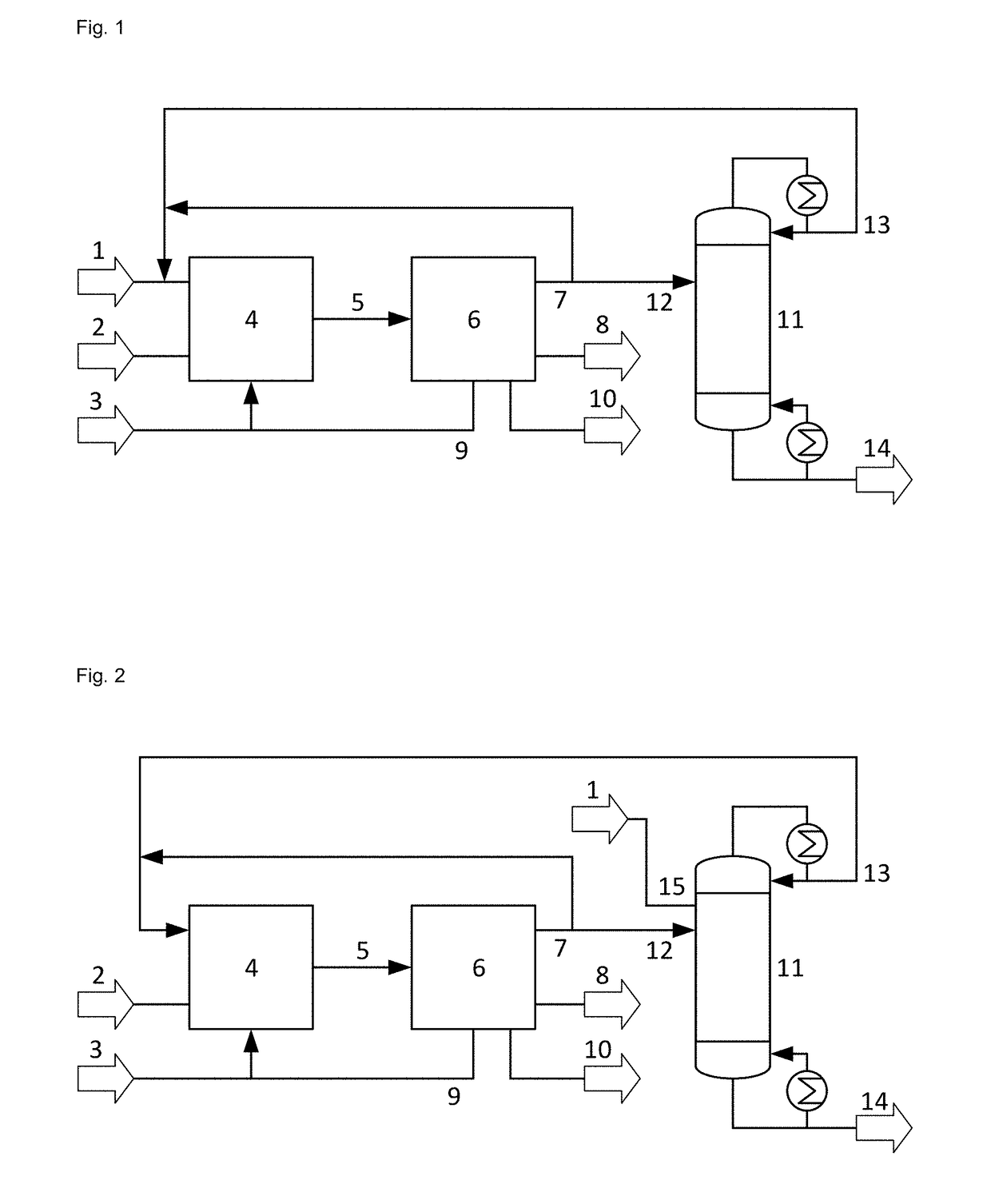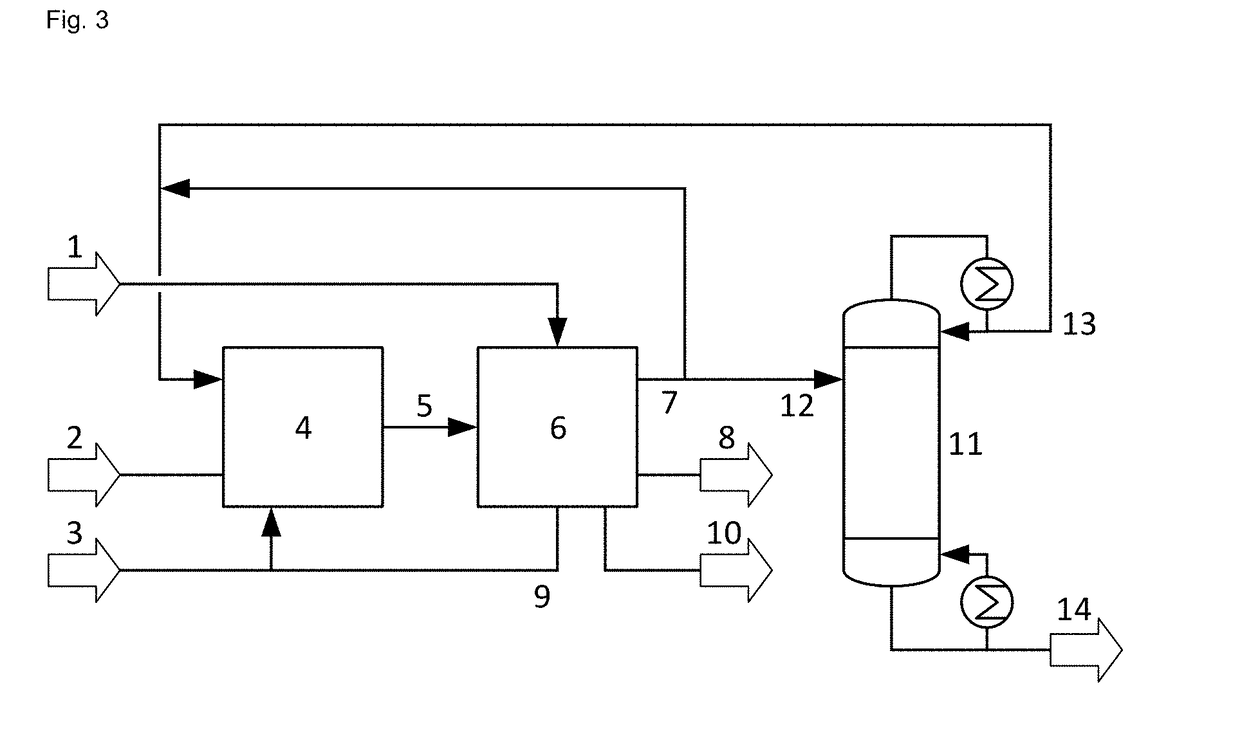Process for the epoxidation of propene
a propene and hydrogen peroxide technology, applied in the field of propene epoxidation with hydrogen peroxide, can solve the problems of high energy consumption, high accumulation of propane, and accumulation of propane in the process, and achieve the effect of reducing equipment siz
- Summary
- Abstract
- Description
- Claims
- Application Information
AI Technical Summary
Benefits of technology
Problems solved by technology
Method used
Image
Examples
example 1
Propene Starting Material Fed to C3 Splitter Column
[0054]For the embodiment of FIG. 2 and an epoxidation with a titanium silicalite catalyst and a methanol solvent providing a reaction mixture containing 28.2% by weight propene and 3.7% by weight propane, the design and operation parameters of the C3 splitter column were calculated with the program Aspen Plus® of Aspen Technology varying the fraction of recovered propene fed to the C3 Splitter column. The calculations were performed for a propene starting material containing 97.5% by weight propene and 2.5% by weight propane. 32.5 t / h liquid propene starting material is fed to the top of a C3 splitter column having 101 theoretical stages operated at 2.3 MPa. The reaction step a) and the separation step b) provide a recovered propene stream of 135 t / h containing 87.2% by weight of propene and 11.5% by weight of propane. A fraction of this recovered propene stream given in table 1 is fed to the 12th theoretical stage of the C3 splitte...
example 2
Propene Starting Material Fed to C3 Rectifier Column
[0056]The calculations of example 1 were repeated, but instead of feeding the propene starting material to the C3 splitter column, the liquid propene starting material is fed to the first theoretical stage (counted from the column top) of a C3 rectifier column of separation step b), providing as overhead product a recovered propene stream of 167 t / h containing 87.2% by weight of propene and 11.5% by weight of propane, a fraction of which is fed as liquid to the top of the C3 splitter column. Table 2 gives the feed rate of recovered propene to the C3 splitter column and the calculated values for the mass fraction of propane in the overhead product stream of the C3 splitter column, the reflux ratio, the reboiler duty (power consumed for evaporation) and the column diameter.
TABLE 2Calculation results for C3 splitter column with propenestarting material fed to C3 rectifier columnMass fractionRecoveredof propanepropene fedtoin C3 splitt...
example 3
Propene Starting Material Fed to C3 Rectifier Column
[0058]The calculations of example 2 were repeated for feeding 70 t / h recovered propene stream to the C3 splitter column and providing an overhead product stream with a mass fraction of propane of 0.106, varying the feed point to the C3 splitter column. Table 3 gives the feed point in theoretical stages from the top of the C3 splitter column and the calculated values for the reflux ratio, the reboiler duty (power consumed for evaporation) and the column diameter.
TABLE 3Calculation results for C3 splitter column with propenestarting material fed to C3 rectifier column and variationof feed point to C3 splitter columnFeed point for recoveredReboilerColumnpropene in theoreticaldutyRefluxdiameterstages from column topin kWratioin m167030.0903.53768620.1163.601271260.1603.712078200.2744.01
[0059]The calculation results demonstrate that for the embodiment where the propene starting material is fed to a C3 rectifier column, feeding the recov...
PUM
| Property | Measurement | Unit |
|---|---|---|
| Percent by mass | aaaaa | aaaaa |
| Percent by mass | aaaaa | aaaaa |
| Fraction | aaaaa | aaaaa |
Abstract
Description
Claims
Application Information
 Login to View More
Login to View More - R&D
- Intellectual Property
- Life Sciences
- Materials
- Tech Scout
- Unparalleled Data Quality
- Higher Quality Content
- 60% Fewer Hallucinations
Browse by: Latest US Patents, China's latest patents, Technical Efficacy Thesaurus, Application Domain, Technology Topic, Popular Technical Reports.
© 2025 PatSnap. All rights reserved.Legal|Privacy policy|Modern Slavery Act Transparency Statement|Sitemap|About US| Contact US: help@patsnap.com


